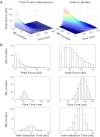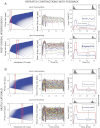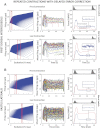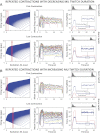Neural control of muscle force: indications from a simulation model
- PMID: 23236008
- PMCID: PMC3602935
- DOI: 10.1152/jn.00237.2012
Neural control of muscle force: indications from a simulation model
Abstract
We developed a model to investigate the influence of the muscle force twitch on the simulated firing behavior of motoneurons and muscle force production during voluntary isometric contractions. The input consists of an excitatory signal common to all the motor units in the pool of a muscle, consistent with the "common drive" property. Motor units respond with a hierarchically structured firing behavior wherein at any time and force, firing rates are inversely proportional to recruitment threshold, as described by the "onion skin" property. Time- and force-dependent changes in muscle force production are introduced by varying the motor unit force twitches as a function of time or by varying the number of active motor units. A force feedback adjusts the input excitation, maintaining the simulated force at a target level. The simulations replicate motor unit behavior characteristics similar to those reported in previous empirical studies of sustained contractions: 1) the initial decrease and subsequent increase of firing rates, 2) the derecruitment and recruitment of motor units throughout sustained contractions, and 3) the continual increase in the force fluctuation caused by the progressive recruitment of larger motor units. The model cautions the use of motor unit behavior at recruitment and derecruitment without consideration of changes in the muscle force generation capacity. It describes an alternative mechanism for the reserve capacity of motor units to generate extraordinary force. It supports the hypothesis that the control of motoneurons remains invariant during force-varying and sustained isometric contractions.
Figures













References
-
- Adam A. Control of Motor Units During Submaximal Fatiguing Contractions (PhD thesis). Boston, MA: Boston University, 2003
-
- Adam A, De Luca CJ. Recruitment order of motor units in human vastus lateralis muscle is maintained during fatiguing contractions. J Neurophysiol 90: 2919–2927, 2003 - PubMed
-
- Adam A, De Luca CJ. Firing rates of motor units in human vastus lateralis muscle during fatiguing isometric contractions. J Appl Physiol 99: 268–280, 2005 - PubMed
-
- Basmajian JV, De Luca CJ. Muscles Alive (5th ed). Baltimore, MD: Williams and Wilkins, 1985
-
- Bawa P, Stein RB. Frequency response of human soleus muscle. J Neurophysiol 39: 788–793, 1976 - PubMed
Publication types
MeSH terms
Grants and funding
LinkOut - more resources
Full Text Sources
Other Literature Sources

